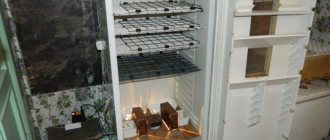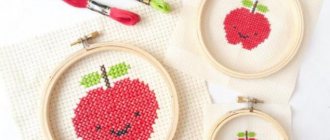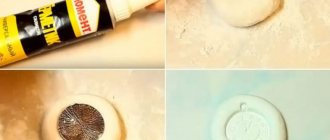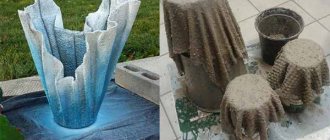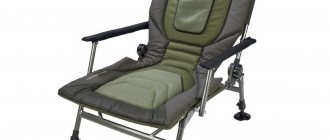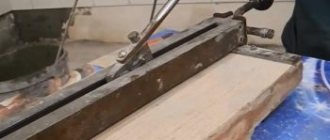The easiest way to sharpen a kitchen knife is to use a regular sharpening stone. However, with this method it is difficult to maintain the correct sharpening angle.
If you sharpen “by eye,” especially if you have no experience, you can completely dull the blade.
To sharpen a knife correctly, we recommend using a special device - a tabletop knife sharpener.
Similar devices are sold in hardware and construction stores.
But why spend money when you can make a knife sharpening device yourself from scrap materials?
In this article we will share with you budget ideas from home craftsmen. We recommend you read it.
What to do with dull knives?
If there are no problems with knives with replaceable blades (naturally, if these same blades are present), then a knife with a sharpened blade must be periodically sharpened. Typically, a special knife sharpening device is used for this.
Buying this now is not difficult. But not everyone prefers this solution to the problem. And the point here is not only the considerable cost of such devices. High-quality sharpeners cost a lot of money.
Many craftsmen will get great pleasure from a machine designed for sharpening knives, made by themselves. Although, even using an ordinary “bare” block, of course, you can sharpen knives with your own hands, but in order to sharpen a knife efficiently using only a whetstone, also known as a “block”, you need to have a certain skill and “steady” hands, because you will need to maintain the sharpening angle identical along the entire cutting edge, and this is not the easiest task. A special sharpener for knives is designed to make it easier, be it factory-made or made with your own hands.
But just to speed up sharpening, any sharpener, both factory-made and home-made, will help.
Knife sharpening basics
Before you get started, you should familiarize yourself with the basic rules and recommendations.
It is believed that a knife should be sharpened at an angle of 20 degrees.
However, it is worth remembering that different types of knives are sharpened at different angles.
Thus it turns out:
- Hunting, pocket and folding at an angle of 30-35 degrees. If you need to sharpen the knife for a sharp blade, at an angle of 40-45 degrees.
- Regular kitchen knives – 25-30 degrees.
- Japanese kitchen ones at an angle of 10-20 degrees.
- Combat knives in 25-30 degree angle.
- Professional kitchen knives are sharpened at an angle of 25 degrees.
The angle must be made small if you need the sharpest knife possible. And if you need to maintain the sharpness of the knife for a long time, then it is recommended to make the angle larger.
The selected angle must be maintained throughout sharpening.
We sharpen with smooth movements, slightly lifting the handle of the knife. Yes, it takes dedication and will likely take some form of habit.
When all the nuances are taken into account, the question arises: “What to sharpen with?”
There are many devices. From the simplest to the most complex. For example: a sharpening stone or, as it is also called, a whetstone, mechanical, electric sharpeners, musat and also Lansky.
You can sharpen a knife with sandpaper, but after sanding the knife will remain scratched.
What are the differences between abrasive stones?
Sharpening stones come in a variety of shapes, bar sizes, and grain sizes. The optimal size of the bar is considered to be one in which its length exceeds the length of the blade of the knife being sharpened by at least one and a half times. This allows you to work with such a bar much more comfortably than with a bar that does not meet this simple requirement.
As mentioned earlier, sharpening stones can have not only different sizes, but also very different grain sizes. There are five main levels of grain size for such bars:
- Grain size 200-300 Extra coarse. In English called Extra coarse. Such bars are not used for sharpening tool blades and knives in particular;
- Grain size 300-350 Coarse grain. In English called Coarse. With the help of such bars, damaged or very dull blades are sharpened;
- Grain size 400-500 Medium grain. In English called Medium. You can do without such a block in the household;
- Grain size 600-700 Fine grain. Called Fine in English, these whetstones are the most popular for sharpening tool blades in the home workshop.
- Grain size 1000-1200 Very fine. In English called Ultra fine. These bars are used for final processing of blades that need to be brought to a shine. Such bars can be used as a tool for a homemade knife sharpener.
Sharpening angle control
When adjusting the sharpening angle, the mechanic performs the following actions:
Throw a large washer onto the pin, which is located in the block of the machine base, and tighten the nut.
The rod does not rotate in the foot; the block for adjusting the sharpening angle is made from a small carbolite block, the dimensions of which are 20x40x80 mm.
15 mm from the block edge, drill a 20 mm end on both sides, widen the gap to 9 mm, then make a thread inside;
He steps back 50 mm from the axis of the new slot and drills another one in the flat part of the workpiece - 90 degrees to the previous one. Such a slot has a diameter of 14 mm. In such a situation, the mechanic strongly flares the hole using a round rasp;
Screws the block onto the stud - sets the desired height of the eye without using fixing screws;
Secures the block on both sides with M10 hex nuts.
Why do knives get dull?
In order to ensure long and comfortable work with a knife after sharpening, first of all try to answer the question, “Why do knives become dull?” Why is it necessary to sharpen the knife again some time after sharpening, and sometimes to completely sharpen the knife again?
The reason for the loss of sharpness by the cutting edge of any tool is this: when working, the cutting edge of a knife or any other tool is exposed to the smallest abrasive particles of the material being cut.
Such particles are found in any material, be it stone, wood, or food.
Even soft vegetables and fruits contain such particles. There may just be more or less of them, but they will definitely be there. Their size, sharpness and quantity only determine the speed at which the instrument will become dull.
Fixation device
The second important part of the tool rest is the clamping bar. It can be made from 2 parts.
L-shaped plank measuring 150x180 mm, the width of the shelves is 50 mm (top);
A rectangle-shaped strike plate measuring 50x100 mm (bottom).
When making a clamping bar, the machine operator performs the following actions:
Places the bottom bar on the far edge of the top bar;
Makes 2 holes in the center and retreats 25 mm from the edges of the part, connects the parts through the holes with two 8 mm bolts;
Screws in 8 mm bolts on 2 sides. In such a situation, the head of the nearest bolt is located near the top bar;
Welds the bolt heads to the plates and grinds them in advance until roundness is formed;
Yes, the inclined board retreats 40 mm from the edge and draws a line with a thicknesser;
Makes one 8 mm 25 mm gap at the bottom and top edges;
Using markings, he connects the edges of the slots and uses a jigsaw to make a cut with an allowance. Use a file to expand the groove to a width of 8.5 mm;
It fastens the planks using a groove that is in the board; the top bolt is tightened with a nut and thus firmly fastens the plank.
Then tightens connection 2 with nut;
When pressing the bottom bar (in the niche of the base), screw a wing nut onto the second bolt.
Sharpening angle, what is it?
So, since it is impossible to stop the process of dulling the cutting edge, then at least try to slow it down, and for this you need to sharpen your tool very well. Earlier in this article you have already come across such a concept as the sharpening angle of the cutting edge. And now more about it.
Blade sharpening angles can vary greatly. From an angle of about 10 degrees for razors and scalpels, to an angle of about 50 degrees for various Machete-type knives.
What could cause such a significant difference?
The fact is that the sharpening angle depends on what materials the blade is supposed to cut. The smaller the angle, the softer the materials should be and vice versa.
The fact is that a blade with a small sharpening angle will not only be easier to cut, but will also become dull more easily. That is why there is not and cannot be a single universal sharpening angle.
Note!
- Do-it-yourself compressor: selection of materials and tools for assembly at home + step-by-step instructions for making and assembling yourself
- Homemade products for the garage with your own hands: options for products for arranging a garage, detailed diagrams and drawings for creating with your own hands
- Do-it-yourself press - design features, choice of manufacturing materials. Step-by-step instructions for making it yourself + simple diagrams and drawings
After reading this article, you will not only learn how to properly sharpen a knife so that it can serve you for a long time until the next sharpening, but also answer your question about how to make such sharpening easier.
To facilitate the correct sharpening of knives, a lot of different tools have been invented, from the simplest devices to the most exotic ones, at a quick glance at which it is not only unclear how to work with them, but it is also difficult to figure out what it is in general.
Recommendation for finishing work
The points outlined above are in many ways the main and almost completely completed work. However, there are some tweaks you can make to ensure that your knife sharpener is great in every way.
- You can coat the box with paint, but it is better to do this before applying varnish. It will also not be superfluous, because it will be able to preserve the paint.
- It is also important to dry everything. There may be some space where the edges of the box end and the stone protrudes.
- It is better to seal it so that moisture does not accumulate.
You just need to have a thin stick (match), with which you can evenly distribute the sealing substance.
The process is very simple, because it is important to ensure that the sealant does not leak beyond the application area. If this happens, you should immediately remove excess from the surface.
What knives can be sharpened?
Not all blades can be sharpened at home, but only blades made from not very hard materials. So, if the hardness of the material from which the blade is made exceeds 55 units on the Rockwell scale (55HRC), then it will not be possible to sharpen it with any tool available to most people. But most of the knives produced now are made of fairly soft materials and such knives are not at all difficult to sharpen.
True, their service life between sharpenings is not long at all.
But no matter what metal the knife is made of, sooner or later it will still have to be sharpened. The only exceptions to this rule are knives with replaceable blades and ceramic knives that cannot be sharpened at all. Thus, a knife sharpening device must be universal, that is, it must be able to sharpen various blades with different sharpening angles.
Note!
- Do-it-yourself winch: classification, manufacturing materials, description of work stages + instructions for DIY construction
Do-it-yourself clamp - step-by-step production and description of options for using a clamp
- DIY knife | A step-by-step description of how and from what materials to make a homemade knife
Therefore, when creating a device for sharpening knives, it is necessary to provide for the possibility of sharpening blades with different angles, and this is the most difficult task both at the design stage and during the manufacture of such a device.
Sharpener cover
You can create a lid to cover the stone. You just need to measure the protruding part of the stone. The depth of the lid (the height of the walls) should be 1-2 mm less than the protrusion of the stone from the box.
With this approach, it will actually be possible to cover the sharpening stone with a lid without disturbing the sealing area. This is an important point to consider when doing important work.
- The lid is nailed together using thin nails. You can use plywood. It needs to be polished.
- Usually done with fine-grained sandpaper. The lid needs to be well treated to avoid splinters.
It's better to coat it with varnish. There is no need to feel sorry for it, but it is important to distribute it evenly. You can use 2 brushes for this.
One of them is soft for basic application, and the other should have hard hairs in order to go through difficult areas with its help. Everything should work out, because the work is simple. Just make sure that the varnish is evenly distributed.
What properties should a sharpener have?
So, before you make a device for sharpening knives with your own hands, you need to think about its design. And to do this, you need to answer the question: what properties should a knife sharpener have:
First, any device for sharpening knives must securely fix the knife, preventing it from falling out, but without damaging the blade material.
Secondly, a homemade knife sharpener must ensure that the block is held at a strictly defined angle, which is necessary for sharpening the entire cutting edge at a constant angle.
Third, the most difficult and perhaps the most important, a sharpening machine for knives, both self-made and factory-made, should allow changing the angle of installation of the sharpening stone; this is necessary to ensure sharpening of various tools and will even allow sharpening of stepped knives.
Note!
- DIY vices: simple and reliable homemade vices from A to Z (190 photos)
- Do-it-yourself vibrating table - selection of materials, components and assemblies for a vibrating table with a step-by-step manufacturing description
- Do-it-yourself grain crusher - operating principle, types and features of creating a device for processing grain crops
Base
When making a sharpening machine at home, you can use various parts. In particular, you can use laminated box plywood 12 mm thick, which was previously used to create radio equipment housings.
When constructing a machine at home, a household member performs the following actions:
Selects a base for such an installation, which must weigh at least 5 kg. Otherwise, it will be impossible to sharpen chopping devices and tools on the machine. Therefore, in the manufacture of such equipment, the tenant uses various steel angles measuring 20x20 mm;
Next, 2 parts are cut out of plywood with a jigsaw, which have a trapezoidal shape, the base is 170 by 60 mm, and the height is 230 mm. When cutting, the mechanic makes an allowance of 0.7 mm for sharpening the ends: they end up straight and fit according to the markings;
Installs 3 parts between the inclined walls on the sides - an inclined surface made of plywood with dimensions of 230 x 150 mm.
In such a situation, the trapezoidal sides are located laterally on a rectangular surface.
The result is a base - a wedge. In such a situation, a protrusion of an inclined surface measuring 40 mm is formed in the front part;
Then, along the side wall ends, the mechanic marks 2 lines with a thicknesser. At the same time, it retreats by half the thickness of the plywood;
Next, he drills 3 holes in the boards to connect the parts of the structure with screws;
Drills the ends of the inclined surface and connects the base parts for a while;
At the back of the structure, the mechanic connects the side walls using a 60x60 mm block, which is attached to the end with two screws on both sides; — makes a 10 mm gap in the block.
In such a situation, it retreats 50 mm from the center - 25 mm from the edge. To maintain a vertical position, first drill with a thin drill from 2 edges, and then expand;
Then, at the top and bottom, two threaded fittings are screwed into the gap, and in the fittings - a 10 mm pin, the length of which is 250 mm.
If the threads do not match the studs, the lower fitting is adjusted.
What will we make it from?
The next question to consider is.
The materials from which you will make it.
To create such a device you will need the following materials:
- A sheet of thick plywood (can be replaced with a sheet of chipboard) 16 mm thick;
- Self-tapping screws 50-70 mm long; (it is better to use furniture format);
- A drill corresponding in diameter and length to your self-tapping screws or conformation;
- M8 hairpin of appropriate length (approximately 70 cm);
- Aluminum plate (at least 5 mm thick);
- M8 bolts with nuts (it is advisable to use wing nuts, although you can also use regular nuts, but keep in mind that then, with each sharpening, you will have to use a wrench, and this, you will agree, is not very convenient);
- You will also need a small block of textolite or ebonite to create a movable connection between the stud and the frame, which can be adjusted in height (if necessary, it can be replaced with a block made of hard wood, for example, it could be oak, beech or hornbeam);
- Of course, you will also need abrasive stones of various grain sizes;
- You will also need a powerful neodymium magnet (“you can get” such a magnet from an old computer hard drive that has become unnecessary).
Using replaceable blocks and making a carriage
When making a sharpening carriage, the machine operator performs the following actions:
Welds 30 cm M10 threaded rods with a smooth rod whose thickness is 10 mm;
Uses 2 solid bars 50x80 mm and the thickness is 20 mm. In all blocks, in the center and on top, 20 mm is retreated from the edge, and then a gap is made 10 mm wide;
Screws a wing nut onto the rod, then a large washer and 2 bars, then a nut and washer;
Clamps rectangular sharpening stones between the stones or makes several replaceable sharpening stones.
As a timber base, the machine operator uses a rectangular tube from a profile or a piece of cornice, the width of which is 50 mm;
He sands the flat machine part and cleans it of grease, and glues strips of sandpaper with a grain size of up to 1200 grit using Super Moment glue.
The sandpaper should have a fabric base, and on one of the blocks you need to glue a strip of suede to apply polish to the blades.
What are we going to do?
The tools you will need are: a drill, a drill of a suitable length and diameter, a screwdriver with bits suitable for your screws or format. Instead of a screwdriver with suitable bits, you can also use a screwdriver (but this will be more difficult).
Any tool for cutting metal (a hacksaw or an angle grinder equipped with a cutting wheel).
How will we do it?
Having asked the question “how to make a knife sharpener?” First of all, let’s find drawings for our future knife sharpener, which we will make with our own hands, and to do this, enter the following query into the search bar: “device for sharpening knives drawings.”
In response to such a request, any search engine will return a large number of suitable search results. Choose the one you like.
Having cut the plywood in any convenient way into parts for our future frame, we drill them at the points of attachment to each other, and then fasten them with self-tapping screws or conformat to each other.
On the frame we fix, using a bolt, an aluminum plate pre-processed according to the drawing (it will serve as a clamp for the knife being sharpened).
Next, we attach a vertical section of the pin to the frame and firmly fix a “cracker” on it. It consists of two parts made of an ebonite block (the Cracker is a very important part, it determines the angle at which the abrasive bar and the blade being sharpened will come into contact).
Now let's create a mount for the abrasive stone: for it we use the remaining section of the pin. Two blocks of ebonite or other similar material and two nuts.
Sharpening machine from mounting angles
There is another way to make a knife sharpener. Here is the second master class.
What will you need?
- metal plates measuring 4x11cm
- aluminum corners
- metal rods at least 15 cm in length
- fasteners
- device for marking when cutting threads
- machine for sharpening metal (can be replaced with a file)
- fixing device (for example, a vice)
- small file (needed when working on smaller parts)
Detailed manufacturing instructions
Step one: You need to make marks to drill the holes.
Step two: You need to make a thread in the holes of the taps.
Step three: For the convenience and safety of using the sharpener, you need to smooth out all the irregularities, blunt the corners, and straighten the edges.
Step four: Next you need to drill grooves in the corners
Step Five: Tapping the Holes
Step six: You need to place the metal rods in the outer holes and secure with nuts
Step seven: Support the entire product - there is a hole in the groove of the base. You need to screw a bolt 14 cm long and 8 cm in diameter into it. You must first strengthen the bolt with one wing nut and two simple ones.
Step Nine: Place nuts in the other holes as well. They hold the part of the knife that needs to be sharpened.
Step ten: Thread nuts onto metal rods and install the corner.
Step eleven: The moment of fixing the abrasive. This is done using a metal rod, which should be in the shape of the letter “L”, a pair of clamps, and a wing nut.
Now it’s time to try out the resulting device.
It will be much easier and more convenient if, while working on the sharpener, you have the opportunity to simultaneously watch a video on the topic and work on the process. The convenience is that if something becomes unclear, you can always stop, slow down or watch the video again.
There are still enough options for making a knife sharpener with your own hands: an angle, a rotary sharpener, a double sharpener, with a vertical mechanism, etc.
What did we get?
Having assembled the design according to the drawing, you will receive the simplest device for sharpening knives, however, despite its simplicity, this device will allow you to sharpen knives and any other blades quite efficiently.
In order to understand how to use such a device, just enter “video knife” in any search engine.
Did you manage to sharpen the knife? Hooray! You have successfully made a DIY sharpening machine.
We should not forget that any sharpening machine, even if it is made by hand, requires strict adherence to the rules and safety requirements!!!



